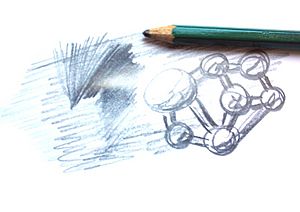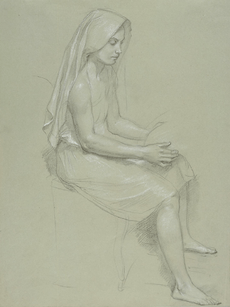Drawing facts for kids
Drawing is a way of making a picture using lines on a surface. Long lines help create shapes, and small lines add textures. Drawings can show things from real life or be abstract images that express ideas not seen in the real world.
A drawing is also the art created this way. Artists use tools like pencils, chalk, charcoal, crayons, pastels, and pen and ink. People have been drawing for many centuries, usually on paper or other surfaces where marks can be seen.
Contents
- What is Drawing?
- How Has Drawing Changed Over Time?
- What Materials Do Artists Use?
- What Are Some Drawing Techniques?
- How Do Artists Show Tone and Texture?
- How Do Artists Show Form and Proportion?
- What is Perspective in Drawing?
- What Makes a Drawing Artistic?
- Why Do Some People Draw Better?
- Images for kids
- See also
What is Drawing?
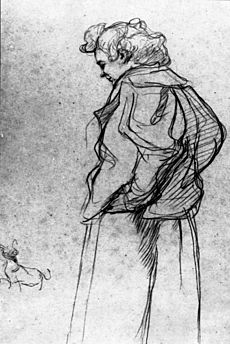
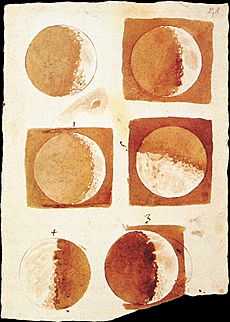
Drawing is a main way to express ideas in visual arts. It mostly involves making lines and shaded areas on paper or other materials. This helps artists show the real world accurately on a flat surface. Old drawings were usually in one color, like black and white. But today, drawings made with colored pencils can look a lot like paintings.
In art, drawing is different from painting, even though they sometimes use similar tools. Dry tools like chalk are often used for drawing, but they can also be used in pastel paintings. You can also draw with liquid ink using brushes or pens. Both drawing and painting can happen on the same surface. Sometimes, an artist will draw a basic sketch, called an underdrawing, before they start painting.
Drawing often involves exploring ideas, looking closely at things, solving problems, and planning how the picture will look. Artists often make drawings as a first step for a painting. These are called studies.
There are many types of drawing, like figure drawing (drawing people), cartooning (making cartoons), doodling (drawing without much thought), free hand drawing, and shading. There are also different ways to draw, such as line drawing, stippling (using dots), and tracing (drawing over an existing image on clear paper).
A quick, rough drawing is often called a sketch. Outside of art, drawings are also used for technical drawings, like plans for buildings, machines, or circuits.
How Has Drawing Changed Over Time?
Drawing as Communication
Drawing is one of the oldest ways humans have expressed themselves. It existed even before written language! People believe drawing was a special way to communicate about 30,000 years ago. Early humans, called Homo sapiens sapiens, made cave and rock paintings. These drawings, called pictograms, showed objects and ideas. Over time, these simple drawings became more styled and led to the written language we use today.
Drawing in Art History
Drawing has always been important in art. For a long time, it was seen as the basic skill for any artist. At first, artists drew on wooden tablets that they could reuse. When paper became widely available in the 14th century, drawing became even more popular in art. Artists used drawing to think through ideas and plan their final artworks. During the Renaissance, drawings became very realistic, influenced by math and philosophy.
When photography was invented, it changed how artists used drawing. Photography could show things very accurately, so artists started to move away from traditional drawing. Modern art then encouraged "imaginative originality," and drawings became more abstract.
Drawing Outside of Art
Drawing isn't just for artists. In the 12th century, monks in Europe made detailed drawings to create illustrated books called illuminated manuscripts. Drawing has also been very important in science. For example, in 1616, the astronomer Galileo Galilei used his drawings to explain the changing phases of the moon. In 1924, scientist Alfred Wegener used drawings to show how the continents might have moved over time.
What Materials Do Artists Use?
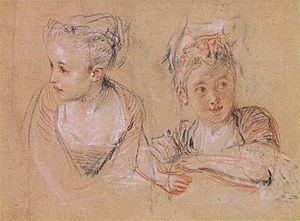
The medium is the material that puts ink, color, or pigment onto the drawing surface. Most drawing materials are dry, like graphite (pencil lead), charcoal, pastels, Conté crayons, or silverpoint. Others use a liquid, like markers or pen and ink. Watercolor pencils can be used dry, then brushed with water for painting effects.
Paper comes in many sizes and types. It can be smooth or rough, and come in different colors. Smooth paper is good for tiny details, but rougher paper holds the drawing material better, which helps create darker contrasts.
Newspaper and typing paper are good for practice or quick sketches. Tracing paper is used to try out ideas on a drawing or to copy a design. Cartridge paper is a common type of drawing paper. Heavier, acid-free boards are used for fine details and won't wrinkle when wet materials like ink are used. Vellum is very smooth and great for super fine details.
Acid-free paper keeps its color and texture much longer than paper made from wood pulp, which can turn yellow and become brittle.
Basic drawing tools include a drawing board or table, a pencil sharpener, and an eraser. For ink drawing, blotting paper is useful. Other tools are a compass (for circles), a ruler, and a set square (for angles). Fixative spray helps stop pencil and crayon marks from smudging. Drafting tape holds paper down and can also protect areas from accidental marks. An easel or slanted table holds the drawing in a good position.
What Are Some Drawing Techniques?
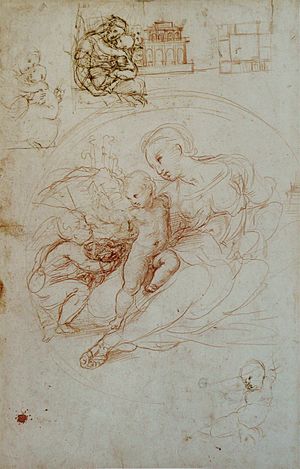
Most artists use their hands and fingers to draw. Before starting a drawing, artists often try out different tools on practice paper to see how they work and what effects they can create.
The way an artist makes strokes affects how the drawing looks. Pen and ink drawings often use hatching (groups of parallel lines). Cross-hatching uses lines going in different directions to make darker tones. Broken lines create lighter tones. Stippling uses dots to create tone, texture, and shade.
Drawings made with dry materials use similar techniques, but pencils can create smooth changes in tone. Artists usually draw from left to right if they are right-handed to avoid smudging their work. Erasers can remove mistakes, lighten areas, and clean up stray marks. In a sketch, lines often follow the shape of the object, creating depth like shadows.
Sometimes, an artist will leave a part of the drawing untouched while filling in the rest. They can use masking fluid or cut-out paper to protect that area. Another way to protect a drawing is to spray it with fixative. This helps the drawing material stick to the paper and prevents smudging. However, fixative sprays should be used in a place with good airflow, like outdoors, because of the chemicals.
Another technique is subtractive drawing. Here, the paper is covered with graphite or charcoal, and then the artist uses an eraser to create the image.
How Do Artists Show Tone and Texture?
Shading is a technique where artists change the lightness or darkness (tonal values) on paper to show how light hits an object and where shadows fall. By carefully looking at reflected light, shadows, and bright spots, artists can make a drawing look very real.
Blending uses a tool to soften or spread the drawing marks. This works best with materials that don't dry instantly, like graphite, chalk, or charcoal. For blending, artists can use a blending stump, tissue, a kneaded eraser, a fingertip, or a piece of chamois. A chamois is also good for making smooth textures and for removing material to lighten an area.
Shading techniques like hatching and stippling also add texture. The type of paper, drawing material, and technique all affect texture. Texture looks more realistic when it's next to a contrasting texture. For example, a rough texture looks more obvious next to a smooth area. A light edge next to a dark background can make an object seem to stand out.
How Do Artists Show Form and Proportion?
Measuring the sizes of things you are drawing is very important for making a realistic picture. Tools like a compass can help measure angles. Artists can also compare the sizes of different parts of the subject. For example, they might use their finger on their pencil to measure one part and then compare it to another. A ruler can also help with measurements and proportions.
When drawing something complex, like a person, it helps to start by drawing basic shapes like cubes, spheres, cylinders, and cones. Almost any shape can be made from these simple forms. Once these basic shapes look like the subject, the artist can refine the drawing into a more accurate picture. The lines from the basic shapes are then erased and replaced with the final details. This way of building a drawing is a key skill in realistic art and helps the final image look correct and consistent.
For drawing people, artists need to understand anatomy and human proportions very well. A trained artist knows about bones, joints, muscles, and how they work together when a person moves. This helps them draw natural poses that don't look stiff. Artists also know that proportions change with age, especially when drawing portraits.
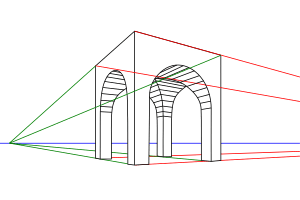
What is Perspective in Drawing?
Linear perspective is a way to draw objects on a flat surface so that they look smaller the further away they are. Imagine parallel lines, like the edges of a building or a table. In a drawing, these lines seem to meet at a single point called a vanishing point. This point is usually on the horizon line.
When you draw the front and side of a building, the parallel lines for the side will meet at a second vanishing point (which might be off the paper). This is called a two-point perspective. If you also make the vertical lines meet at a third point (above or below the horizon), it's a three-point perspective.
Artists can also show depth in other ways:
- Size: Objects that are the same size in real life should look smaller the further away they are.
- Texture: As an object gets further away, its texture looks more squished and less clear.
- Contrast and Color: Artists can reduce the contrast and make colors less bright for distant objects. This creates an effect like atmospheric haze, making your eye focus on objects in the foreground.
What Makes a Drawing Artistic?
The way an image is arranged, called its composition, is very important for making an interesting piece of artistic merit. Artists plan where to place elements in their drawing to share ideas and feelings with the viewer. Good composition helps the drawing look balanced and pleasing.
How the subject is lit, or its illumination, is also key. The play of light and shadow is a powerful tool for artists. Where the light comes from can change the message of the drawing. For example, many light sources can smooth out wrinkles on a face, making someone look younger. But a single, strong light source can highlight every texture and interesting feature.
When drawing an object or person, a skilled artist pays attention to both the object itself and the space around it. The space outside the main subject is called negative space. It can be just as important as the subject in making the drawing look right. Objects in the background should also appear correctly placed.
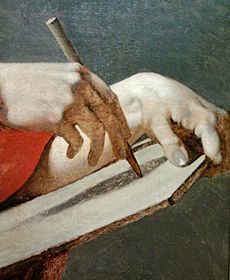
A study is a practice drawing made before a final artwork. Studies help artists figure out how specific parts of the final image will look or try different ways to achieve their goal. Sometimes, a well-made study can be a work of art on its own, with many hours of careful work put into it.
Why Do Some People Draw Better?
Some people are better at making drawings that look exactly like what they see. These are called "visually accurate" drawings. Scientists have studied why some people draw better than others.
One idea is that four main things help with drawing:
- How well you see the objects you are drawing.
- Your ability to make good choices about how to represent things.
- The motor skills (hand movements) needed to make marks.
- How you see your own drawing as you work on it.
Many studies suggest that how well you perceive (see and understand) an object is the most important part of drawing accurately. This idea is supported by the strong link found between perception and drawing ability.
This evidence was the basis for Betty Edwards' famous drawing book, Drawing on the Right Side of the Brain. Edwards aimed to teach people to draw by helping them improve their perceptual skills. The artist and critic John Ruskin also stressed the importance of perception in his book The Elements of Drawing, saying, "For I am nearly convinced, that once we see keenly enough, there is very little difficult in drawing what we see."
Your Visual memory (how well you remember what you see) also helps. Short-term memory is important because your eyes constantly move between the object you're drawing and your drawing itself.
Some studies show that artists spend more time thinking strategically while drawing compared to non-artists. Artists often think about different plans for how they might continue with a drawing.
Images for kids
-
Albrecht Dürer, Self-Portrait at the Age of 13, 1484
See also
 In Spanish: Dibujo para niños
In Spanish: Dibujo para niños


